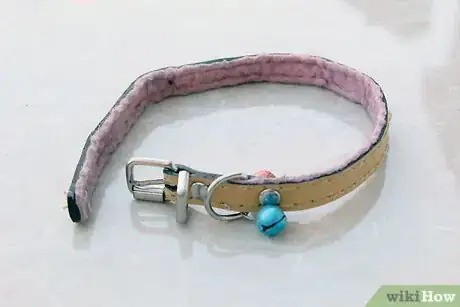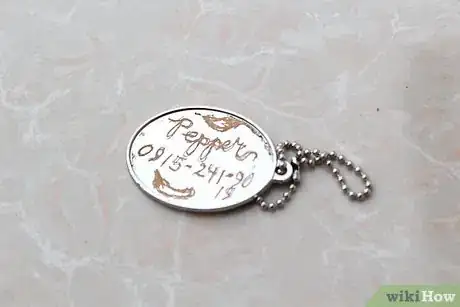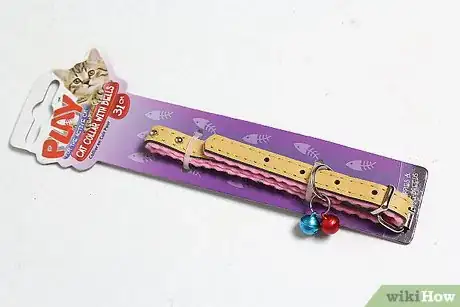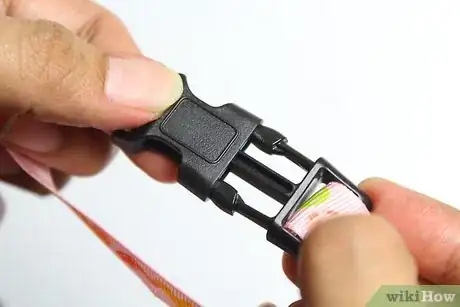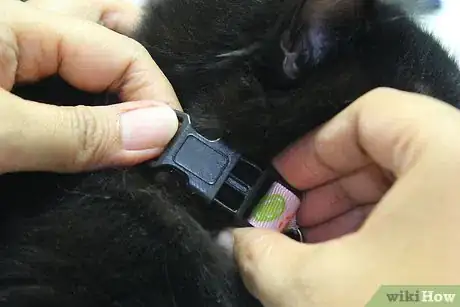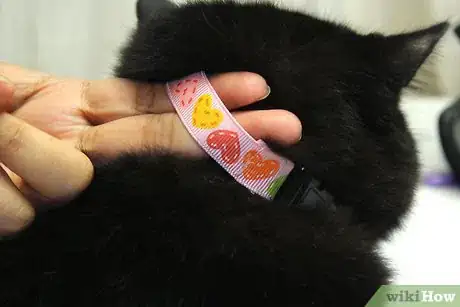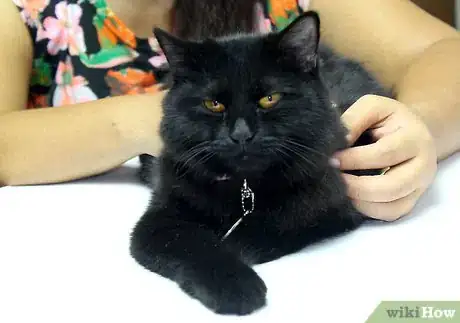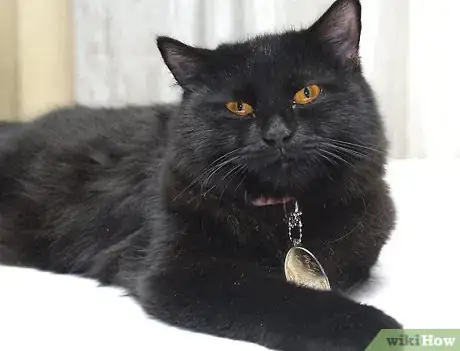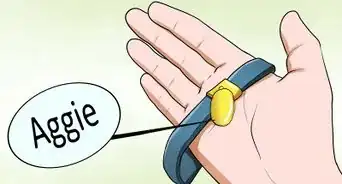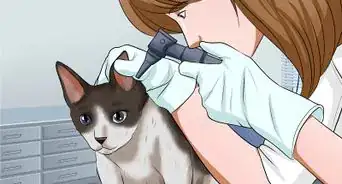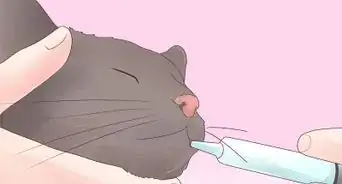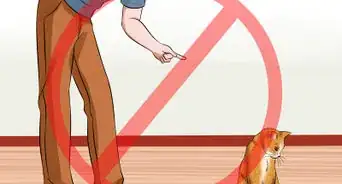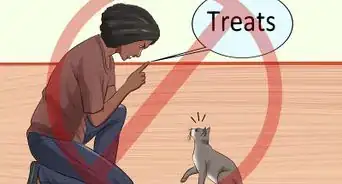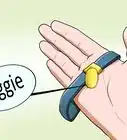This article was co-authored by Pippa Elliott, MRCVS. Dr. Elliott, BVMS, MRCVS is a veterinarian with over 30 years of experience in veterinary surgery and companion animal practice. She graduated from the University of Glasgow in 1987 with a degree in veterinary medicine and surgery. She has worked at the same animal clinic in her hometown for over 20 years.
This article has been viewed 75,549 times.
A collar is a necessity if you have an outdoor cat. If your cat gets lost or hurt, a collar can be used to get him home safe. Collars should be worn since kittenhood, to get cats used to the feel. Make sure you know how to safely put a collar on your kitten to assure his health and safety.
Steps
Choosing a Collar
-
1Keep safety in mind. As cats, unlike dogs, are able to climb and jump in a variety of places, safety concerns for collars are of particular importance. Make sure you select a collar that will not harm your kitten.
- Avoid collars made from elastic or those that contain elastic inserts. As these are stretchable, cats have been known to push their legs through in attempt to get the collar off. This can result in cuts the upper leg and joint injury.[1]
- Over-the-counter flea collars sometimes contain chemicals harmful to cats. In fact, many flea repellents should not be used by kittens at all. Talk to your veterinarian about flea control rather than buying a collar yourself.[2]
- For a kitten, who is likely very playful, your safest choice is a breakaway or quick release collar. These collars are secured with a breakaway clasp that will come undone in response to pressure. This prevents your kitten from inadvertently choking if the collar gets snagged on anything.
-
2Find a tag. The main reason cats and kittens need collars is identification purposes. Less than 2% of kittens in animal shelters are returned to their owners, so it's important to have your contact information with your kitten in the event he gets lost.[3]
- If possible, choose a tag that doesn't hang. Hanging bits, like tags and bells, are a safety concern as these can snag on tree branches and other outdoor hazards. This increases the risk of choking. A breakaway collar minimizes the risk, however. If you have a breakaway collar, a non-hanging tag might not be necessary.[4]
- Tags are available online or at local pet stores. Non-hanging tags clip flat on a collar. Your tag should include your name, your cat's name, your phone number, and other contact information.[5]
Advertisement -
3Browse different styles and designs. You have many different style options when it comes to picking a collar for your kitten. Kitten collars come in many different colors and patterns, and are made of many different materials. A simple leather collar might be better if you're mainly just concerned with function, but you may want to try a collar that has beads, sequins, or jewels if you're going for something more fashionable.[6]
Putting on the Collar
-
1Make sure the breakaway buckle works correctly. If the buckle is defective, this defeats the purpose of a breakaway clasp.
- Place your finger under the collar and pull. It should come undone in response to pressure. If it doesn't, have the collar exchanged for one with a working clasp.[7]
- As you don't want to put the kitten's collar on twice, which can cause undue stress, conduct this test using a stuffed toy.
-
2Allow the kitten to familiarize itself with the collar. Place the collar on the floor and allow your kitten to inspect it as his discretion.
- Gently coax your kitten into the room where the collar is. Never rush a cat or kitten, as this can cause stress and elevate the situation's tension.[8]
- Let your kitten sniff the collar and familiarize himself with it.[9]
- If possible, rub your kitten's fur on a towel and rub the towel on the collar. That way, the kitten's scent will be on the cloth and the collar will smell familiar. You can also rub the collar on the kitten's bedding or toys.[10]
-
3Place the collar around the kitten's neck. Once the kitten is familiar with the collar, you can safely place it around his neck.
- Pet the kitten for a minute to calm him down. You do not want him to start off his relationship with his collar on stressful grounds.
- Once he's calmed, gently wrap the collar around his neck. If he starts to resist and pull against the collar stop, let him relax, and try again. You do not want to cause strain to his neck. The collar should not pull against his throat while it's being secured. If he squirms, you may need to enlist the help of another person.
- Fasten the breakaway clasp until you hear a soft clicking. Undo the towel restraint and release your kitten.
Considering Safety
-
1Test the collar's fit. A collar should fit snugly without causing strain to your kitten's neck. Make sure the collar fits your kitten properly after putting it on.
- Ideally, the cat's collar should be snug enough that you can slide two fingers under the collar. If you can fit more than that, tighten it. If you can fit less, loosen it.[11]
-
2Supervise your kitten at first. Your kitten needs to be supervised when first using the collar. Do not simply let him wander unsupervised until he's accustom to the collar.
-
3Understand the benefits outweigh the risks. Many people are wary of putting collars on cats or kittens due to perceived health risks. However, with proper precaution collars are very safe and beneficial especially if you have an outdoor cat.
- In a study conducted through Ohio State University, 538 collared cats were studied for a six-month period. At the end of the study, the majority of the cats were still wearing their collars and only a few suffered injuries. None of the injuries were serious or fatal.[14]
- Collars greatly increase the chance that, if lost, the cat will be returned. While microchipping is also an option, cats are not always checked for a microchip if found and oftentimes cats without collars are assumed to be stray or abandoned.
Warnings
- Check the collar frequently. Kittens grow fast, and he'll probably need new collars every few months until he's full grown.⧼thumbs_response⧽
- Before letting the kitten go outside, be sure it has been microchipped, spayed/neutered, and has all its shots.⧼thumbs_response⧽
References
- ↑ http://icatcare.org/advice/how-choose-and-fit-collar-your-cat
- ↑ http://icatcare.org/advice/how-choose-and-fit-collar-your-cat
- ↑ http://www.nytimes.com/2010/09/14/science/14obcats.html?ref=science
- ↑ http://www.adoptapet.com/blog/are-collars-safe-for-cats/
- ↑ http://www.adoptapet.com/blog/are-collars-safe-for-cats/
- ↑ https://www.pethub.com/article/pet-care/cat-collars-101
- ↑ http://www.adoptapet.com/blog/are-collars-safe-for-cats/
- ↑ http://www.vetstreet.com/our-pet-experts/towel-wrap-your-cat-in-5-scratch-free-steps
- ↑ http://www.woaw.org.au/teachers/cat-collars-choosing-training/
- ↑ http://www.woaw.org.au/teachers/cat-collars-choosing-training/
- ↑ http://www.adoptapet.com/blog/are-collars-safe-for-cats/
- ↑ http://www.adoptapet.com/blog/are-collars-safe-for-cats/
- ↑ http://www.adoptapet.com/blog/are-collars-safe-for-cats/
- ↑ http://www.nytimes.com/2010/09/14/science/14obcats.html?ref=science
About This Article
Before you put a collar on a kitten, make sure it's a breakaway or quick-release collar so your kitten doesn't choke if it gets snagged on something. Then, place the collar on the floor, and give your kitten time to sniff and inspect it. Next, when your kitten is calm, place the collar around its neck and secure it with the clasp. Finally, test the collar's tightness by slipping 2 fingers under it. If you can't, the collar is too tight. For more tips from our Veterinary co-author, like how to keep your kitten safe while it's wearing a collar, scroll down!
